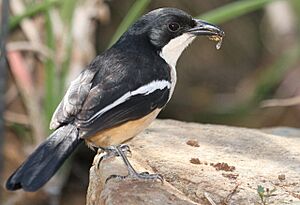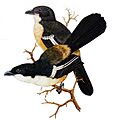Southern boubou facts for kids
Quick facts for kids Southern boubou |
|
|---|---|
 |
|
 |
|
| Conservation status | |
| Scientific classification | |
| Genus: |
Laniarius
|
| Species: |
ferrugineus
|
The southern boubou (Laniarius ferrugineus) is a type of bushshrike. Its scientific name, ferrugineus, means 'rust-coloured'. These birds are passerines, which means they are perching birds. They were once thought to be related to true shrikes, but scientists now know they are not closely related.
You can find the southern boubou in southeastern Africa. This includes southeastern Zimbabwe, eastern Botswana, Mozambique, and southern and eastern South Africa. They like to live in thick bushes in forests, mangroves, and gardens. In drier areas, they prefer woodlands near rivers.
Contents
What is a Southern Boubou?
The southern boubou is a medium-sized bird, about 20–22 cm long. The male has black feathers on its upper body, from its head to its tail. It has a bright white stripe on its wing. Its tail is long and black with white feathers on the sides.
Its belly is white, turning to a reddish-brown colour on its lower belly and sides. Its beak, eyes, and legs are all black.
How to Tell Males and Females Apart
Female southern boubous look a lot like the males. However, their upper body is dark grey, and their chest has a reddish-brown tint. Young birds look similar to females. They have mottled buff-brown feathers on top and a buff colour on their wing stripe. Their underside has a barred pattern.
The reddish-brown colour on their belly helps tell them apart from other boubou birds. It also makes them different from the southern fiscal, which looks a bit similar. The southern boubou has a shorter tail and more white on its wing. It also tends to hide more.
Southern Boubou Behavior
Unlike some other shrikes that sit out in the open, the southern boubou likes to stay hidden. It searches for food in thick plants close to the ground. This is why people sometimes call it a shy bird.
What Do Southern Boubous Eat?
Their main food is insects. They find insects on the ground or pick them off plants while moving low in bushes. They also eat small rodents, lizards, snails, and fruits.
Southern Boubou Calls
Southern boubous are known for their special calls. They often sing in a duet, which means two birds sing together. One bird might make an ooo-whee-ooo sound, and another will follow with a whistled ooo-ooo-wheee or wheee-wheee followed by ooo-whee-ooo. These duets can change a lot. Sometimes, their ooo-whee-ooo call sounds like a black-headed oriole. When they sense danger, they make a quiet cluck sound.
Reproduction and Life Cycle
The female southern boubou usually builds the nest. It's a shallow cup shape, often placed in a climbing plant or a thick bush. She lays about two greenish-white eggs, which have brown spots.
Both the male and female take turns sitting on the eggs. This incubation period lasts for 16–17 days until the chicks hatch. Both parents also bring food to their young. The chicks leave the nest after about 16 more days. Sometimes, about 2% of their nests are taken over by black cuckoos, which lay their eggs in the boubou's nest.
Images for kids





